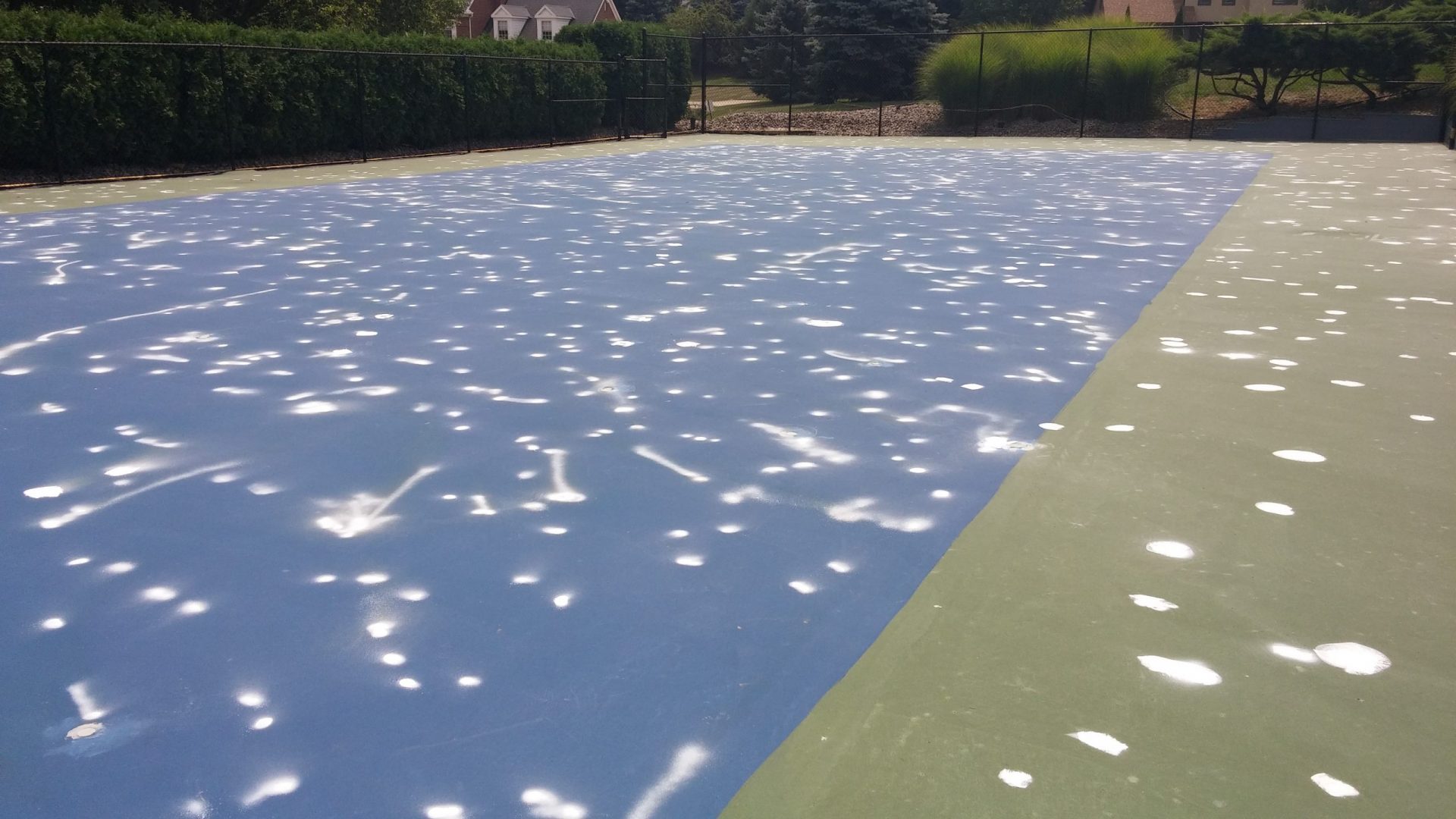Tennis Court Rust Spot Repair Options

Remediation offers various solutions, but the following are the ones most frequently discussed:
- Remove the contaminated aggregate.
- Cover the contaminated aggregate with an acrylic surface coating utilizing a rust inhibitor/stain blocker.
- Cover the contaminated aggregate with a polyurethane surface coating.
- Cover the contaminated aggregate with a tennis court “mat” system.
- Cover the contaminated aggregate with a new surface course of asphalt.
Option 1 – Remove the Aggregate:
Summary – Contractor drills out all the visible iron pyrite. The holes are patched with an acrylic patch binder. Apply rust inhibitor and new court surface paint.
- Pros – The source of the staining is completely removed from the surface.
- Cons – May not get every piece of iron pyrite.
- Cost – Medium, labor-intensive
- Level of Success – High
Option 2 – Cover aggregate with an acrylic surface coating for tennis courts utilizing a rust inhibitor/stain blocker:
Summary – Contractor applies rust inhibitor. Either paint on exposed aggregate, covers the entire court, or both; one or two coats. Some products are installed as a primer, while some are mixed with the color coatings. The initial coat is intended to “encapsulate” the iron pyrite. Products mixed in with the surface are intended to minimize staining. The rust inhibitor products are generally products developed to improve bonding to greasy or oily surfaces. These are what encapsulates the iron.
- Pros – Simple installation. Common in many industries.
- Cons – Iron pyrite that is not exposed is not “encapsulated.” Latex is a permeable breathable surface. The permeability allows moisture into the surface which can contact iron that is not encapsulated which will then rust and stain the new surface. Be aware that rust spots will come back through the surface. The rate of success is as low as 60% to as high as 85%. Rust can be expected to reappear in two to five years.
- Cost – Medium
- Level of Success – Medium
Option 3 – Cover the contaminated aggregate with a polyurethane surface coating:
Summary – A polyurethane waterproofing membrane is installed across the entire court.
- Pros – The polyurethane coating is non-permeable, which stops surface water from reaching the iron pyrite.
- Cons – Trapping moisture under the surface and not allowing it to breathe could cause blistering. Moisture from under the surface being heated on hot summer day, forcing water vapor to rise and hit the iron pyrite, causes rust which may push through the surface.
- Cost – Medium-high
- Level of Success – Medium to high
Option 4 – Cover the contaminated aggregate with a “mat” system:
Summary – A thick (+/- 3/16”) mat court system is installed across the entire court area.
- Pros – The surface is guaranteed for 25 years. The surface will prevent asphalt cracking, the most common failure mechanism for outdoor asphalt courts, from reaching the surface.
- Cons – Below surface water could push through the surface carrying rust particles and stain the surface.
- Cost – Very high
- Level of Success – High
Option 5 – Cover the contaminated aggregate with a new surface course of asphalt:
Summary – Install a new course of asphalt with properly sourced aggregate and re-paint courts.
- Pros – Extends life to the existing courts.
- Cons – Requires milling or raising of net posts will have a lip at the fence edges.
- Cost – Medium-high
- Level of Success – High
Sources of Information:
- Paul Harris, California Products – Internationally known tennis court surface manufacturer.
- Rob Righter, Nova Sports U.S.A. – Internationally known tennis court surface manufacturer.
- Andreas Schulze Ising, American Polymer Technologies (APT) – Internationally known polymer company specializing in sports surfaces.
- Jeff Gearheart, SportMaster Coatings – Nationally known tennis court surface manufacturer (also has pavement sealant side of business).
- Chuck Sperrick, Neyra Industries – National tennis court surface manufacturer (also has pavement sealant side of business).
- Jeff Henderson, Tennis Technology – Regional Tennis Contractor.
- Jim Lathrop, Total Tennis – Regional Tennis Contractor.
- Rich Vettle, ABCO Paving – Regional Tennis Contractor.
- David Baird, Industrial Surface Sealer, Inc. – Regional Pavement Maintenance Contractor.